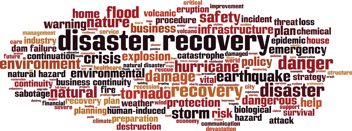Why You Need Regular Risk Assessments for Disaster Recovery and Business Continuity

Disaster Recovery (DR) and Business Continuity (BC) planning are essential for any organization, as they help ensure that the company can continue to operate in the event of a disaster. However, to develop an effective disaster recovery and business continuity plan, it is critical to conduct a risk assessment on an annual basis to understand your business risk as your business changes and cyber risks grow in type and complexity.
A DR and BC risk assessment is the ongoing process of identifying and evaluating potential risks to an organization's operations, assets, and individuals. It helps organizations understand the likelihood and impact of different types of disasters and enables them to prioritize their disaster recovery and business continuity efforts accordingly.
Here are a few key reasons why a risk assessment is critical to a company's disaster recovery and business continuity programs:
- Helps identify potential threats: A risk assessment helps organizations identify potential threats to their operations, such as natural disasters, cyber-attacks, or human error. This information is crucial for developing effective disaster recovery and business continuity plans.
- Prioritizes risks: A risk assessment helps organizations prioritize the risks they face. This allows them to focus their efforts on the most critical risks and allocate resources accordingly.
- Guided decision-making: A risk assessment provides organizations with the information they need to make informed decisions about their disaster recovery and business continuity plans. For example, a risk assessment may highlight the need for a specific type of backup or disaster recovery solution.
- Compliance: Many industries and regulations require organizations to conduct regular risk assessments as part of their disaster recovery and business continuity planning. This helps organizations comply with industry regulations and standards, such as HIPAA, PCI-DSS, and ISO 22301.
- Cost-effective: By identifying potential risks and prioritizing them, organizations can develop effective disaster recovery and business continuity plans without overspending on unnecessary measures.
In the last decade, cyber-attacks have become one of the biggest risks to an organization and the steps taken to protect against these attacks require additional assessment and planning to ensure an effective overall DR/BC program. A cyber security risk assessment is an important best practice used to protect any organization from the potential consequences of a cyber-attack. It is a process of identifying and evaluating potential vulnerabilities and threats to an organization's information systems, networks, and data. Conducting a cyber security risk assessment is critical in developing an effective disaster recovery and business continuity plan.
Here are reasons why a specific cyber security risk assessment is critical to a company's disaster recovery and business continuity programs:
- Helps identify potential vulnerabilities: A cyber security risk assessment helps organizations identify potential vulnerabilities in their networks and systems, such as outdated software, unpatched systems, or weak passwords. This information is crucial for developing effective disaster recovery and business continuity plans.
- Prioritizes risks: A cyber security risk assessment helps organizations prioritize the risks they face, such as critical systems and sensitive data. This allows them to focus their efforts on the most critical risks and allocate resources accordingly.
- Guided decision-making: A cyber security risk assessment provides organizations with the information they need to make informed decisions about their disaster recovery and business continuity plans. For example, a risk assessment may highlight the need for a specific type of backup or disaster recovery solution.
- Compliance: Many industries and regulations, such as HIPAA, PCI-DSS, and ISO 27001, require organizations to conduct regular cyber security risk assessments as part of their disaster recovery and business continuity planning. This helps organizations comply with industry regulations and standards.
- Cost-effective: By identifying potential vulnerabilities and prioritizing them, organizations can develop effective disaster recovery and business continuity plans without overspending on unnecessary measures.
A cyber security risk assessment is a critical step in protecting any organization from the potential consequences of a cyber-attack and augments your overall Risk Management program. It helps organizations identify potential vulnerabilities, prioritize risks, guide decision-making, and comply with regulations. It is essential for organizations to conduct regular cyber security risk assessments as part of their disaster recovery and business continuity planning. Ballast Services specializes in both Disaster Recovery/Business Continuity and cyber security Risk Assessments, planning, remediation, and optimization. Our team of consultants can help you navigate your Risk Management programs as well as cyber insurance and compliance standards which require comprehensive Risk and Cyber security programs.
Modernize, Optimize, Stabilize, and Secure your organization today. Contact us at 813-568-9011, visit our website at https://ballastservices.com, or click on Get In Touch to speak with us today.



